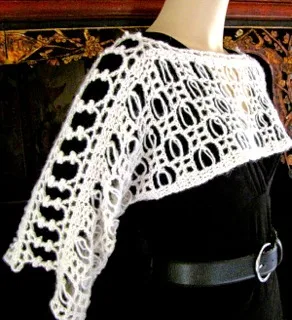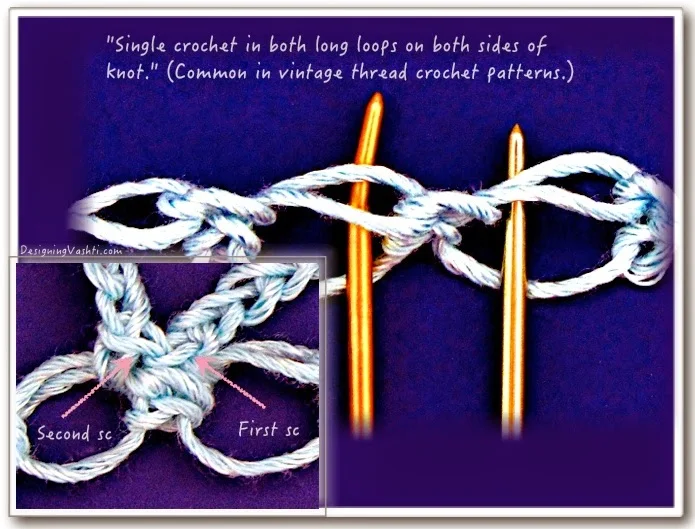Crocheters often have trouble matching both stitch gauge and row gauge with filet crochet. Not only do we vary in how tall we make our double crochets (dc; tr in the UK); we also tend to make chain stitches (ch sts) tighter than other stitches. There are lots of ch sts in filet!
Minuet Vest by Vashti Braha: Regular filet crochet (left); Tunisian filet crochet (right).
The stitch gauge is how many stitches measure 4" or 10 cm in a row. The row gauge is how many rows stack up to 4" or 10 cm.
Sometimes Tunisian filet crochet can bail you out. Below I list some of my current favorite Tunisian crochet alternatives, along with some common methods non-Tunisian filet crocheters use to achieve the stitch and row gauge they need.
“Getting gauge” both horizontally and vertically (i.e., stitch and row gauges) is especially important when you want to create a picture with filet lace. Some of those antique filet charts are stunning. Getting gauge is also a big priority when you’re crocheting clothing in a particular size, like the unusual Minuet Vest design pictured here. Depending on the project, just getting the stitch gauge might be sufficient, and you could add or subtract a few rows if your row gauge is off. (I guess you could consider this gauge strategy #1; just don’t use it for pictorial filet!)
The Minuet Vest can be crocheted in regular filet crochet (1 treble crochet + 2 chain stitches) like the light yellow one shown, or you can create the same vest with Tunisian crochet stitches (like the cherry red one shown). It's more important to get both the stitch gauge and row gauge stated in the Minuet Vest pattern then whether you use the same exact stitches I used.
Kind of unusual – and freeing – isn't it?
Tips for Fine-Tuning Your the Filet Crochet Gauge
 |
| Aquarienne |
Filet crochet is easy to learn, but I consider this topic to be intermediate level for Tunisian crochet. To see if you're ready for it, bop over to this post for a sec.
This is not a complete list, but I hope it's a helpful starting point. If you have a favorite method for adjusting your filet crochet gauge, please leave a comment.
I'm not sure how useful the Tunisian tips will be if you're mostly doing fine thread filet crochet. I haven't found (yet) that I can use Tunisian crochet with thread as fine as I can comfortably use with regular crochet sts. When I use a yarn finer than fingering wt (size #5 cotton thread or CYC #1) with lacy Tunisian crochet sts, I start to prefer fine-textured wools and blends over the traditional glossy crochet cotton threads for lace.
Tip #1: If you’re using a text pattern (not just a chart), first check whether the pattern you're using is written with British/Australian crochet abbreviations, or with American ones. For example, a treble crochet (tr) outside of the USA is called a double treble. That's another yarn over!
Stitch Gauge in regular filet crochet
The stitch gauge is actually determined by the top two loops of every stitch of a row (and their size is supposed to be determined by the hook size). Find out your best hook size for the project by getting your stitch gauge right; then tweak your row gauge below. If you don't have enough stitches for every 4” along a row, swatch again with a slightly smaller hook size. If you have too many, swatch with a slightly larger hook size.
Tip #2: It’s common for crocheters to decide to crochet the ch sts tighter or looser. Doing so consistently throughout a whole project requires creating a new stitching habit, which is easier for some than others.
Tip #3: Ch 1 more to add a bit of width, or ch 1 fewer to subtract a bit of width between the tall sts. Filet crochet is unusual because often what matters is the size ratio between your chs and tall stitches rather than the specific tall stitch, or number of chs, you use! So, if your ch-2 spaces are too wide, try a swatch with just a ch-1 space.
Tip #4: Here are some tips for tightening loose top loops of tall crochet stitches while crocheting them. It could have an impact on your overall filet stitch gauge.
Tip #5: One way to subtly alter the top loops of tall filet sts is to crochet the next row into them differently. Some crocheters crochet into both top loops plus a third horizontal loop just under the top loops of the tall stitch. Twisting a top loop as you crochet into it will tighten it. Inserting your hook into the loop from the opposite direction will twist it. This tweak is much less common in regular crochet than in Tunisian, though, because it changes the traditional texture.
 |
| Left: Tunisian Knit Double Crochet (Tdc; in UK, Ttr) + 1 Tyo Right: Regular Double Crochet (UK: tr) + Ch-1 |
Stitch Gauge in Tunisian filet crochet
You can't merely ch 1 or 2 to make a space like you would in regular filet crochet. Instead, you could:
Tip #6: During the Forward Pass, use 1 or more Tunisian Yarn Overs (Tyo). During the Return Pass, crochet it off of the hook just like any other Tunisian stitch. Click here for how to do this simple, useful stitch.
- Compared to the ch sts in regular filet, each Tyo tends to be looser and adds more width to the row. For my Minuet Vest, this slightly looser effect was exactly what I needed. As you can see in the yellow regular filet version, the filet spaces are narrow. I preferred them a bit wider, closer to square, to make edging them easier. If your regular filet matches the gauge in the Minuet pattern, feel free to substitute.
 |
| Ennis Revelation: Tunisian Filet Crochet |
- Note that this is a nonstandard Return Pass, requiring you to remember to add a ch in specific places. Like chs in regular filet, the result tends to be tight. It is not my first choice for crocheting draping clothing, so I have not experimented with it much.
Row Gauge in filet crochet
Getting row gauge frustrates some, but to me, subtly altering the height, drape, and silhouettes of tall sts is an art in itself. Here are some examples of how to make three different tall sts that fall somewhere between a dc and a tr in height:
Tip #9: Start off each tall st with longer or shorter “legs.” Begin a tr like usual: yarn over your hook twice, insert hook in designated stitch, yarn over and pull up a loop--but pull up this loop a bit less high than you normally do for shorter legs, or a bit higher than usual for longer legs. Crocheters all over the world vary in how high they pull up this first loop when they make the taller stitches such as tr.
Tip #10: Substitute the tall sts in the pattern with extended sts. The heights of extended sts fall in between the basic tall sts. For a st that is a bit shorter than a tr, try an extended dc (edc); an extended tr (etr) would be a bit taller than a tr. To make the edc: Yarn over the hook once, insert hook in designated stitch, yarn over and pull through stitch (3 loops on hook), yarn over, pull through one loop on hook, yarn over, pull through two loops on hook, yarn over and pull through remaining two loops on hook.
Tip #11: Compare the subtleties of these three swatches: First swatch filet rows of tr sts with shorter legs, and one of dc with longer legs. Then make a third swatch of edc and compare the three in terms of stitch gauge, looks, feel, and which you enjoyed crocheting more.
What about Tunisian filet crochet? What if the Tunisian rows are not tall enough? We can make tall and taller Tunisian crochet stitches too, for example the Tunisian Double Crochet (Tdc; in UK, Ttr) or Treble Crochet (Ttr; in UK, Tdtr).
Tip #12: Like regular crochet, there's no limit to how tall you can go with Tunisian sts; and like regular crochet, sometimes you need a st that's in between a Tdc and Ttr. I find that crocheting a tall stitch into a twisted front vertical bar adds a surprising amount of height to the stitch. I didn't need it for the Minuet Vest. On the other hand, Tunisian Knit stitches (between front and back vertical bars and under all horizontal bars of the Return Pass), such as a Tdc or Ttr Knitwise, limits the stitch height.
-:-----:-
I love that Tunisian crochet adds to the possible choices for filet lace. Sometimes I prefer the look and feel of the Tunisian option. All Tunisian crochet stitches face the front, which adds a polished look; see the two swatches above.
There are more options that I'm sure I've never even heard of yet. Filet crocheters have had over a century to develop all kinds of ingenious solutions!













.jpg)
.jpg)











